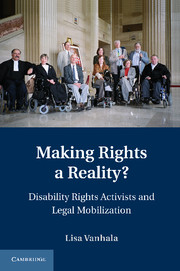Book contents
- Frontmatter
- Contents
- List of Figure and Tables
- Acknowledgments
- Abbreviations
- 1 Introduction: Legal Mobilization and Accommodating Social Movements
- 2 Rights and Political Identity in the Canadian Disability Movement
- 3 Disability Equality and Opportunity in the Supreme Court of Canada
- 4 Disability Organizations and the Diffusion of Rights in the United Kingdom
- 5 Framing Disability Equality in the UK Courts
- 6 Conclusions: Litigation, Mobilization, and Social Movements
- Bibliography
- Index
3 - Disability Equality and Opportunity in the Supreme Court of Canada
Published online by Cambridge University Press: 03 May 2011
- Frontmatter
- Contents
- List of Figure and Tables
- Acknowledgments
- Abbreviations
- 1 Introduction: Legal Mobilization and Accommodating Social Movements
- 2 Rights and Political Identity in the Canadian Disability Movement
- 3 Disability Equality and Opportunity in the Supreme Court of Canada
- 4 Disability Organizations and the Diffusion of Rights in the United Kingdom
- 5 Framing Disability Equality in the UK Courts
- 6 Conclusions: Litigation, Mobilization, and Social Movements
- Bibliography
- Index
Summary
INTRODUCTION
Achieving constitutional recognition of disability rights was an enormous legal and political victory for disability activists in Canada. Rights on paper, however, are simply the first step on a long journey toward true equality on the ground. As shown in Chapter 2, disability advocacy organizations in Canada have been among those that have seized the potential of the equality rights contained within the Charter, and they have relied, to a large extent, on the Supreme Court and lower courts and tribunals to do so. Organizations within the movement have influenced emerging notions of human rights and equality, and they have legally mobilized to advance their own conceptions of the appropriate paradigms of disability, discrimination, and accommodation of difference. Here I address the following questions: What has the Charter provided to Canadians with disabilities in terms of equality? How has the Supreme Court of Canada (SCC) interpreted what equality means? Have the aspirations been met of disability rights activists who campaigned so vigorously for the inclusion of disability as a protected ground in Section 15 of the Charter?
The fact that the Court has the power to shape understandings of constitutional and legislative rights and protections is beyond doubt. By tracing trends in case law on equality and disability issues, we can understand why it is important from a policy perspective that groups have turned to the courts.
- Type
- Chapter
- Information
- Making Rights a Reality?Disability Rights Activists and Legal Mobilization, pp. 108 - 145Publisher: Cambridge University PressPrint publication year: 2010



